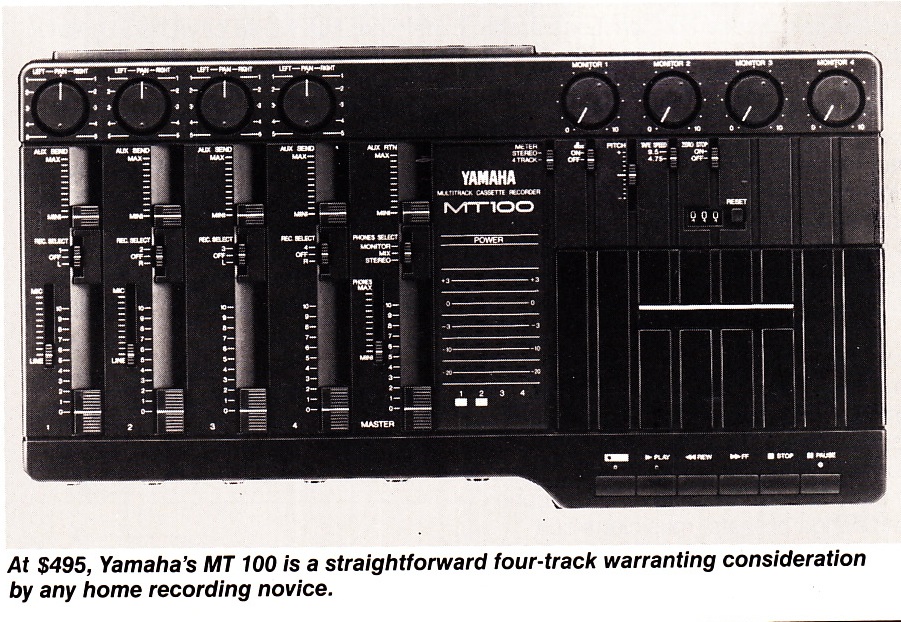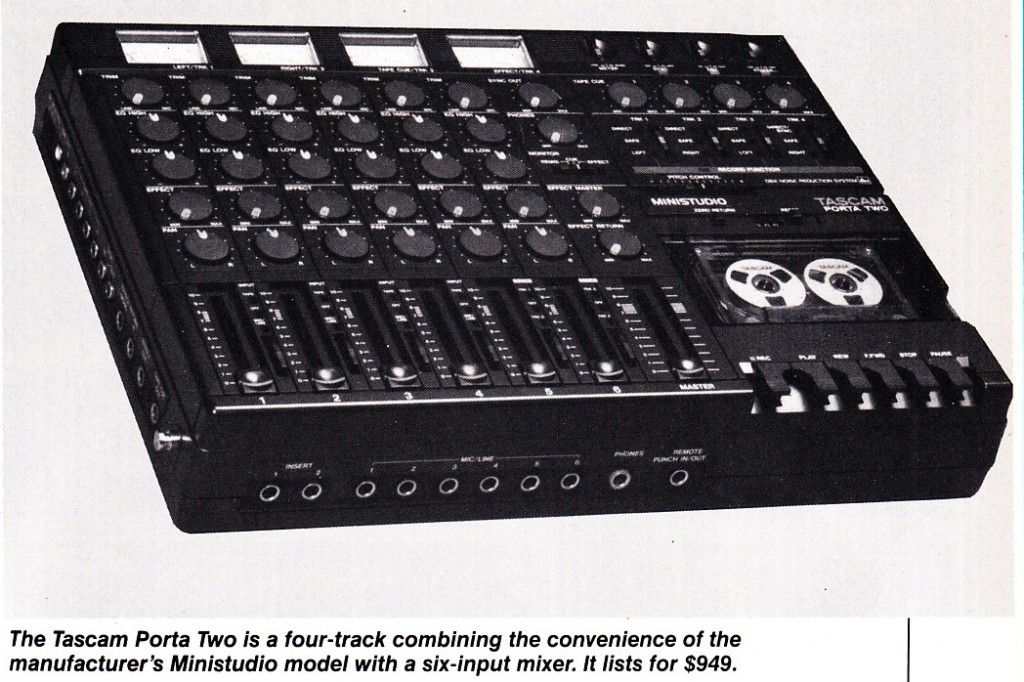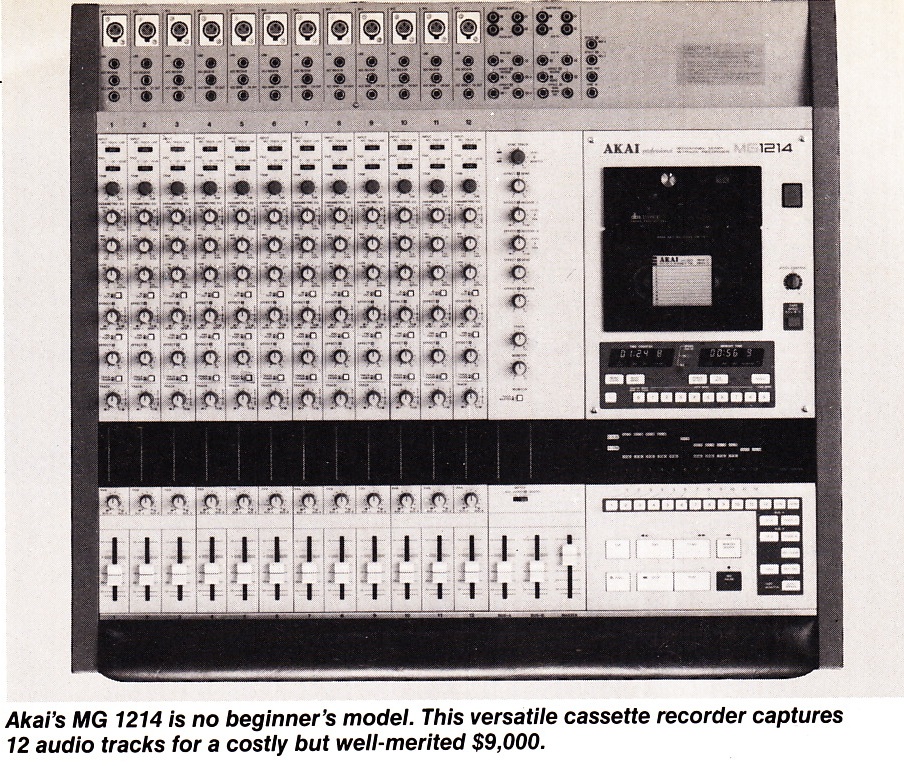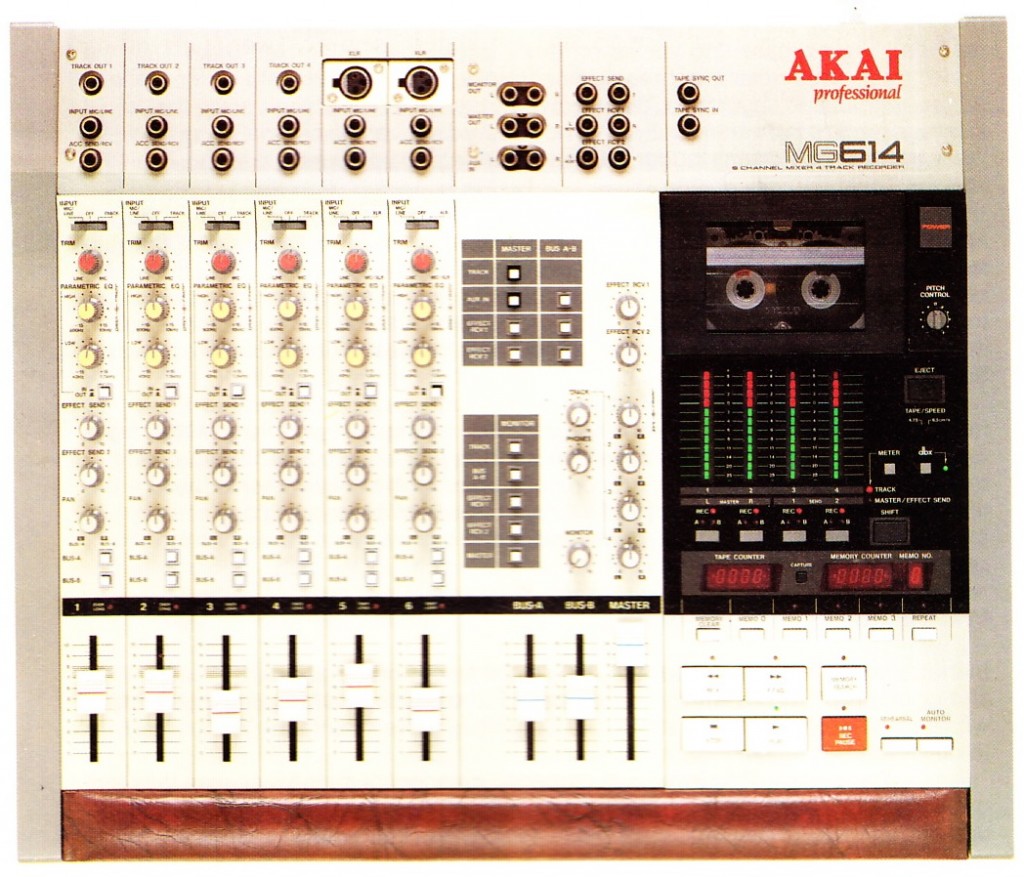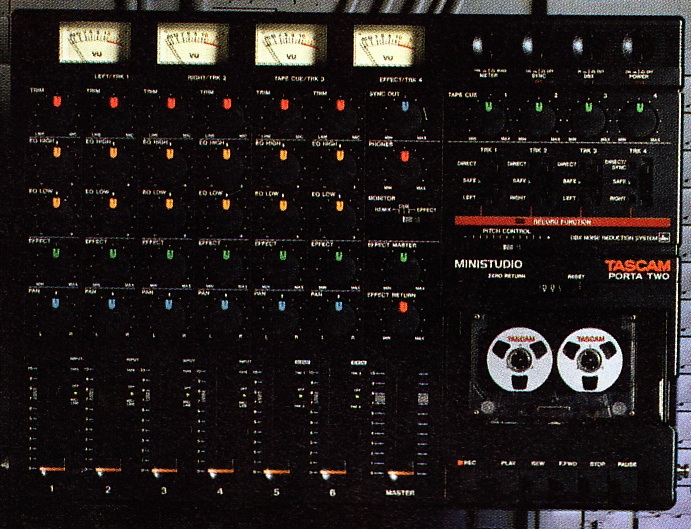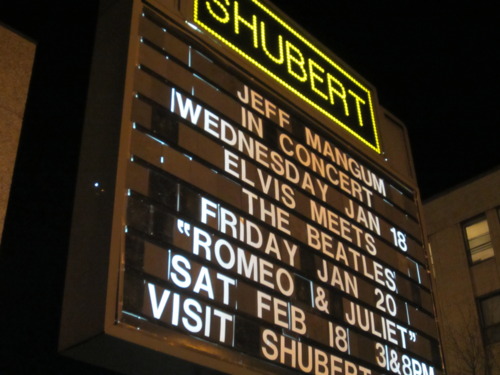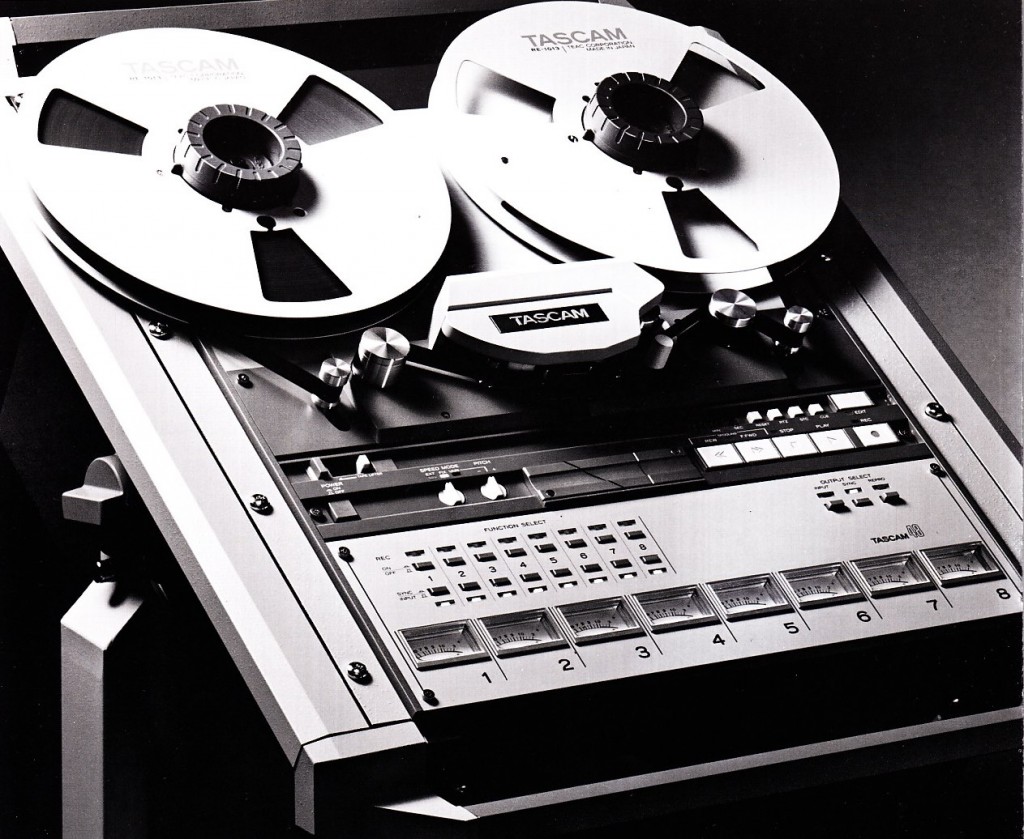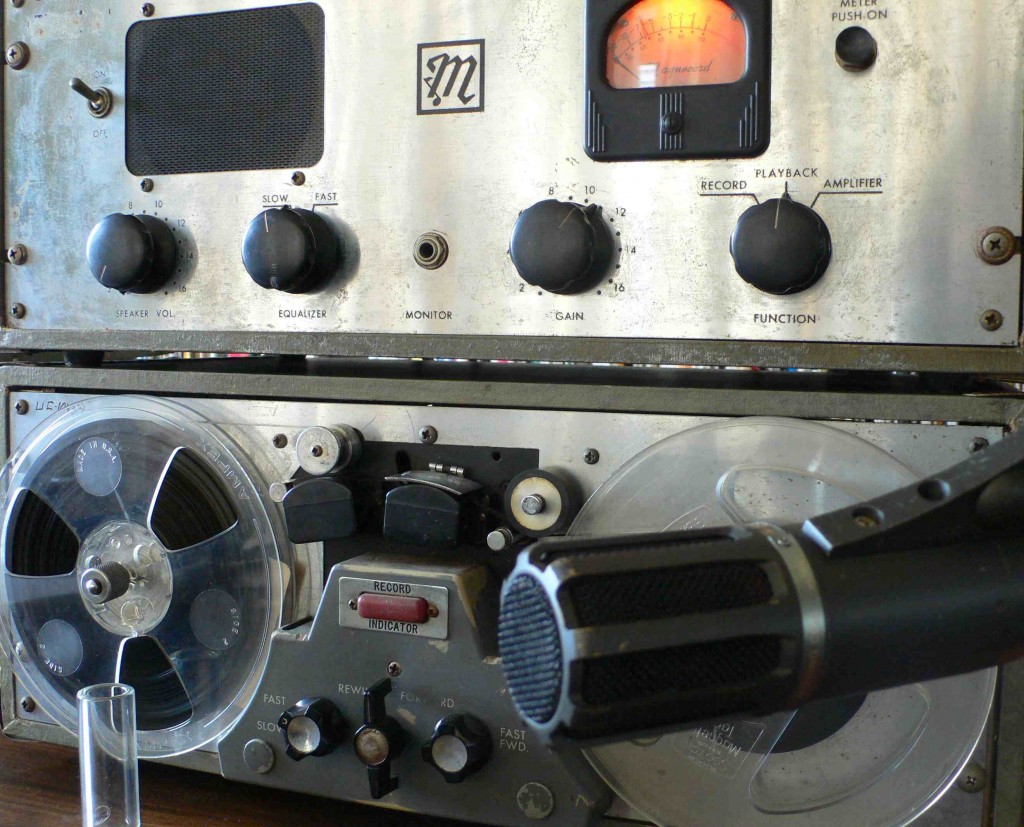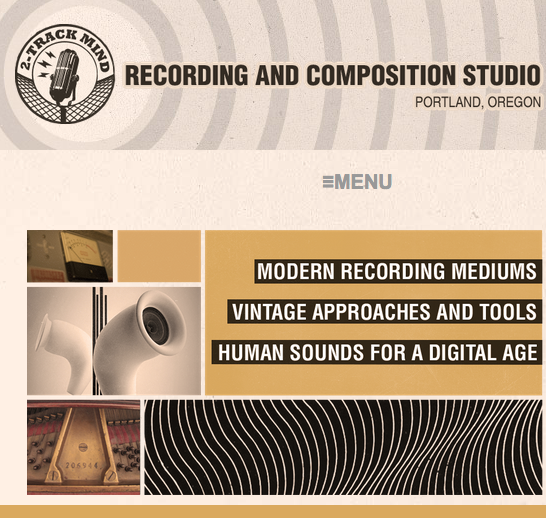 Hey y’all: the cassette-tape experimentation series continues with a new piece created on the amazing Tascam 134 machine. I’ve written about it as a guest-spot on Seth Lorinczi’s Two Track Mind blog. Click this link to hear the track and check it out,,,
Hey y’all: the cassette-tape experimentation series continues with a new piece created on the amazing Tascam 134 machine. I’ve written about it as a guest-spot on Seth Lorinczi’s Two Track Mind blog. Click this link to hear the track and check it out,,,
Tag: tascam
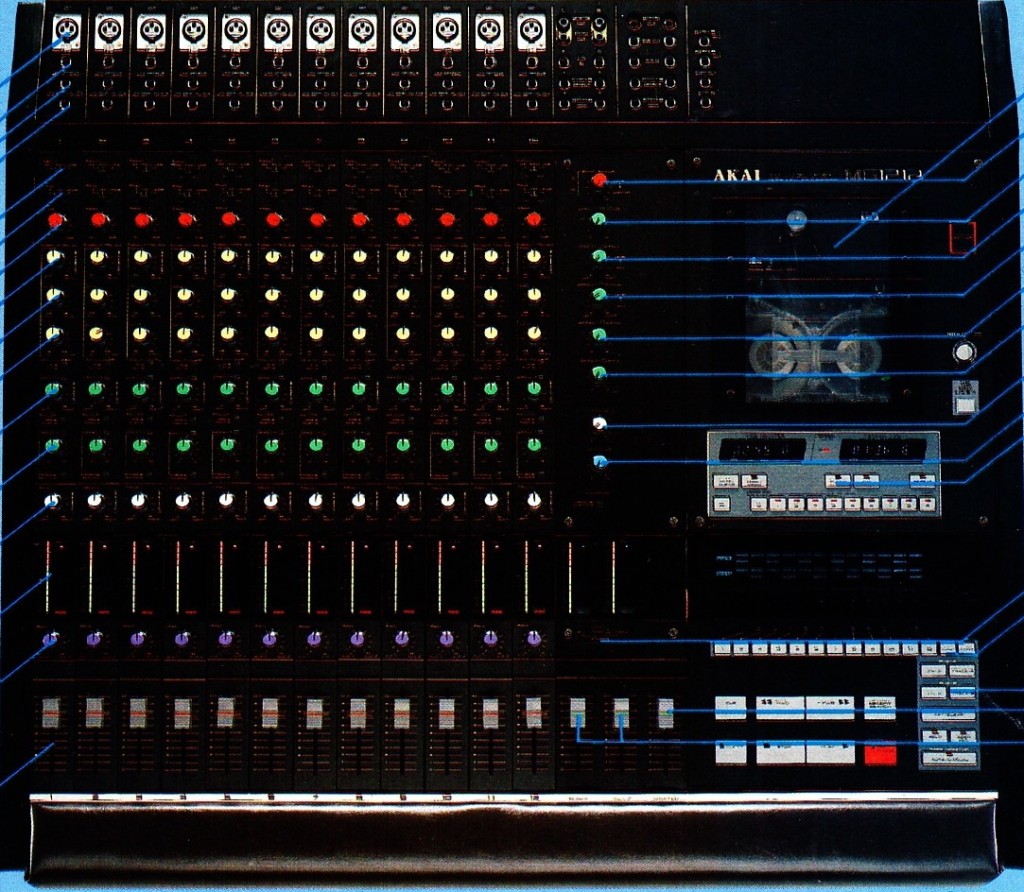 Today: just a few of the ‘Uber’ home-recording machines available to musicians in the 1980s. To this list I would also add the Audio Technica RMX64 and the AMR System 1, both which we have already covered recently at PS dot Com. If anyone is using these things to make music nowadays, drop us a line and tell us about it!
Today: just a few of the ‘Uber’ home-recording machines available to musicians in the 1980s. To this list I would also add the Audio Technica RMX64 and the AMR System 1, both which we have already covered recently at PS dot Com. If anyone is using these things to make music nowadays, drop us a line and tell us about it!
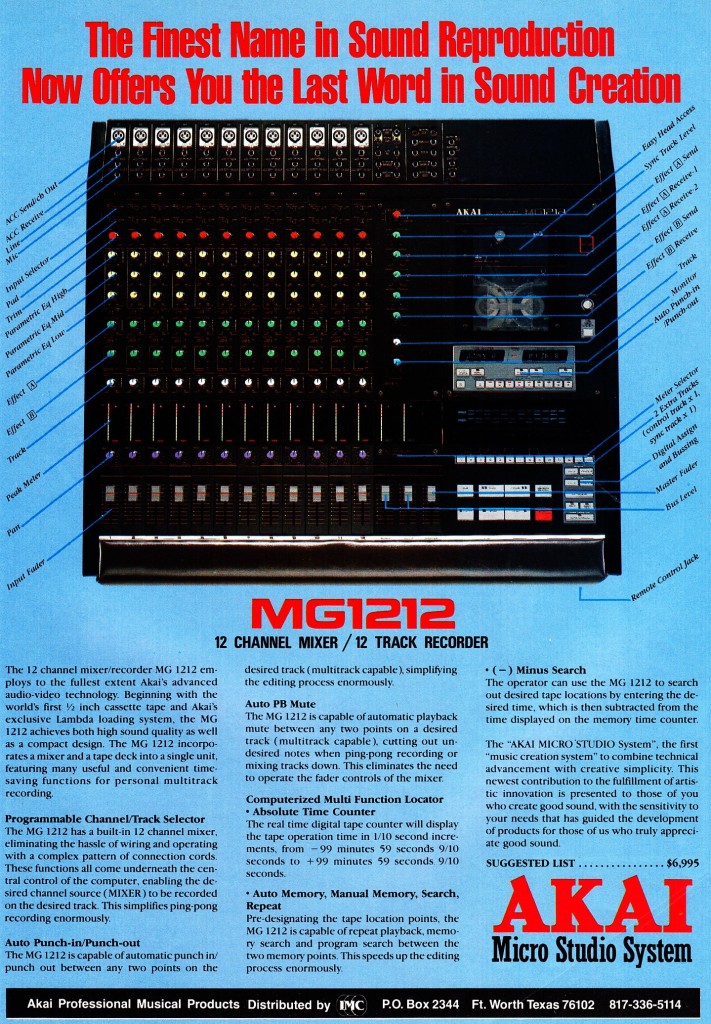 Above: the Akai MG1212 integrated 12-track recorder/mixer; all analog with automated punch in/out and VCA mute. I have a coupla memories of these things. When I was a kid East Coast Music mall had a used one that they were trying to sell for years. It sat at the front of the shop and it looked to me like a fkkn NASA computer. Years later, my college band The Cam Neely was invited to Boston to work with some Berklee students who needed to record some bands for… I have no idea frankly. And oh shit I have the ‘CD’ right here: the engineer’s name was Skip Hoefsmit. He recorded us on one of these machines, and I have to say, the recording sounds good considering i think we did two songs in about 6 hours and the only ‘production’ was that dude doubletracked our vocals. Hey Skip, still hustlin’? Drop us a line…
Above: the Akai MG1212 integrated 12-track recorder/mixer; all analog with automated punch in/out and VCA mute. I have a coupla memories of these things. When I was a kid East Coast Music mall had a used one that they were trying to sell for years. It sat at the front of the shop and it looked to me like a fkkn NASA computer. Years later, my college band The Cam Neely was invited to Boston to work with some Berklee students who needed to record some bands for… I have no idea frankly. And oh shit I have the ‘CD’ right here: the engineer’s name was Skip Hoefsmit. He recorded us on one of these machines, and I have to say, the recording sounds good considering i think we did two songs in about 6 hours and the only ‘production’ was that dude doubletracked our vocals. Hey Skip, still hustlin’? Drop us a line…
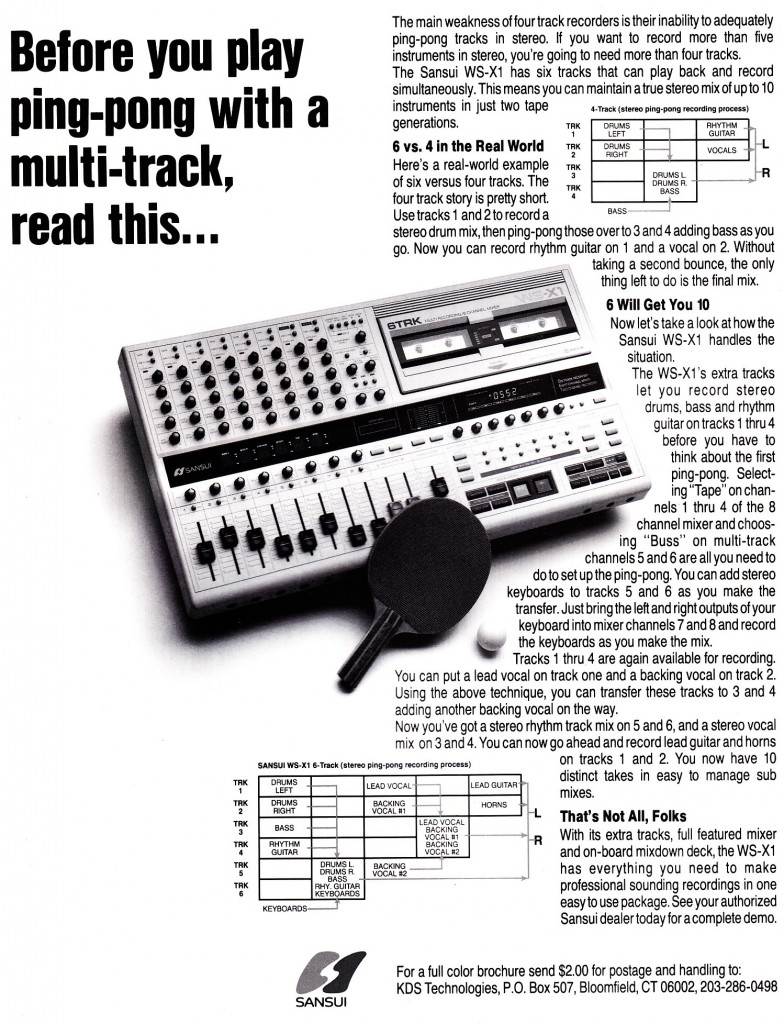 Above: the Sansui WS-X1 of 1990. OK so this thing is fkkn nuts. You get six discrete tracks on a cassette tape, built in digital reverb unit, and stereo mixdown deck, all in one unit. Some dude has a wordpress site solely devoted to this thing, and goddamn I want one of these!
Above: the Sansui WS-X1 of 1990. OK so this thing is fkkn nuts. You get six discrete tracks on a cassette tape, built in digital reverb unit, and stereo mixdown deck, all in one unit. Some dude has a wordpress site solely devoted to this thing, and goddamn I want one of these!
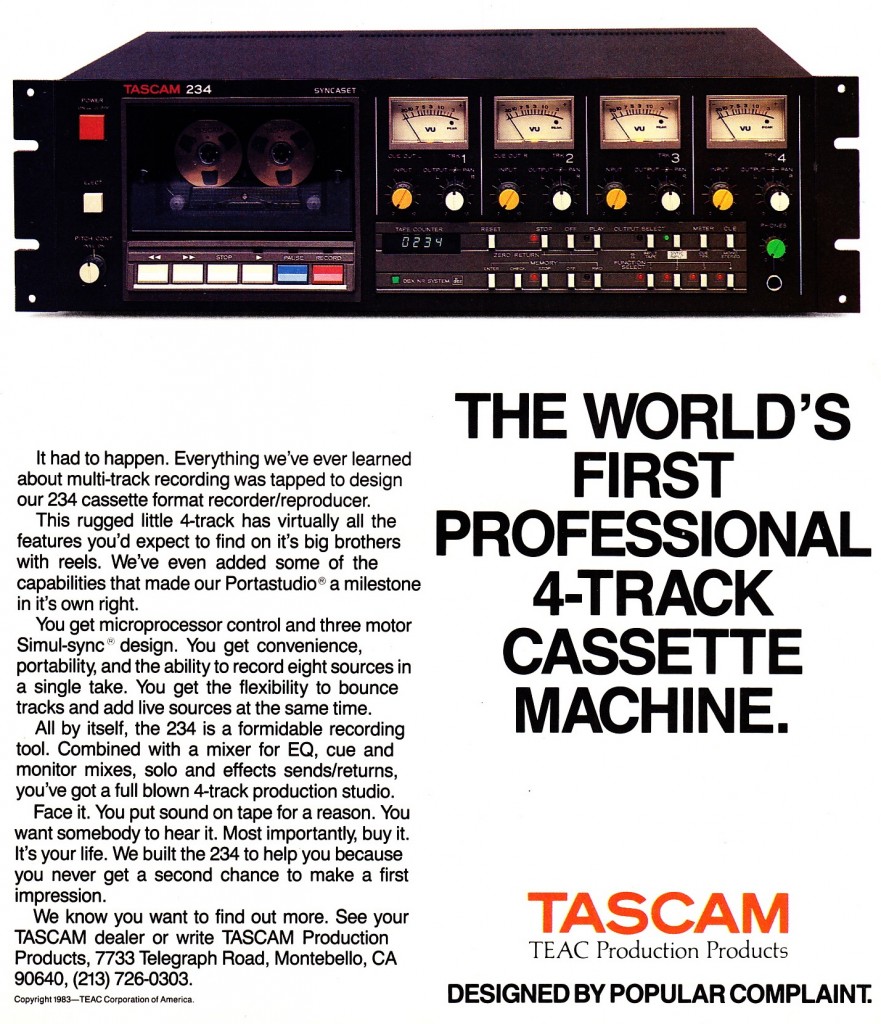 Ah Tascam 234. Someday you will be mine. I actually found one of these at a tag sale in Norwalk last year, $60 I think??? but it was totally dead. Despite all claims made by the seller. Luckily I keep a cassette tape and a pair of headphones in my car at all times (WOW that is so embarrassing) for these sorta occasions, so i was able to scope it and didn’t get snookered. Fkkn asshole DID manage to sell me some dead 10″ guitar speakers for $5 each though. Alright here’s an idea guys: when yr shit breaks, either fix it, have it fixed, or take it to the town recycling center. DON’T STORE IT IN THE BASEMENT AND THEN STICK SOMEONE ELSE WITH IT 5 YRS LATER. For fukks sake, why do people keep broken crap around? We’re inundated with enough WORKING crap. Jesus.
Ah Tascam 234. Someday you will be mine. I actually found one of these at a tag sale in Norwalk last year, $60 I think??? but it was totally dead. Despite all claims made by the seller. Luckily I keep a cassette tape and a pair of headphones in my car at all times (WOW that is so embarrassing) for these sorta occasions, so i was able to scope it and didn’t get snookered. Fkkn asshole DID manage to sell me some dead 10″ guitar speakers for $5 each though. Alright here’s an idea guys: when yr shit breaks, either fix it, have it fixed, or take it to the town recycling center. DON’T STORE IT IN THE BASEMENT AND THEN STICK SOMEONE ELSE WITH IT 5 YRS LATER. For fukks sake, why do people keep broken crap around? We’re inundated with enough WORKING crap. Jesus.
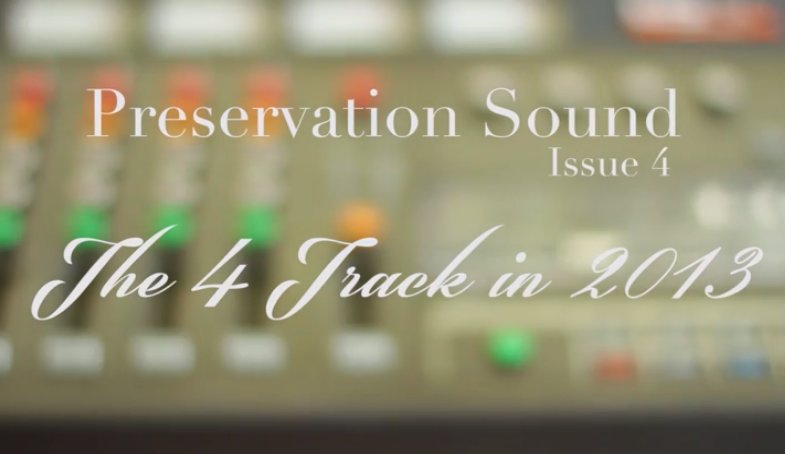 I am v v pleased to announce that PSV #004 is now online. “The 4-track in 2013” looks at the possibilities that an old-school cassette 4-track machine offers when used in conjunction with a digital audio workstation. We do this through the work of John Panos, aka KINGS. Panos’ music is some of the best new stuff I’ve heard in a while, and he has some really insightful things to say about tape noise and distortion and how these things work as both an arrangement element and a sonic frame, situating parts of the track within an historical context informed by the legacy of cassette-distributed popular music. Check it.
I am v v pleased to announce that PSV #004 is now online. “The 4-track in 2013” looks at the possibilities that an old-school cassette 4-track machine offers when used in conjunction with a digital audio workstation. We do this through the work of John Panos, aka KINGS. Panos’ music is some of the best new stuff I’ve heard in a while, and he has some really insightful things to say about tape noise and distortion and how these things work as both an arrangement element and a sonic frame, situating parts of the track within an historical context informed by the legacy of cassette-distributed popular music. Check it.
For more about KINGS, check out:
KINGS website / Blog / Music / Twitter
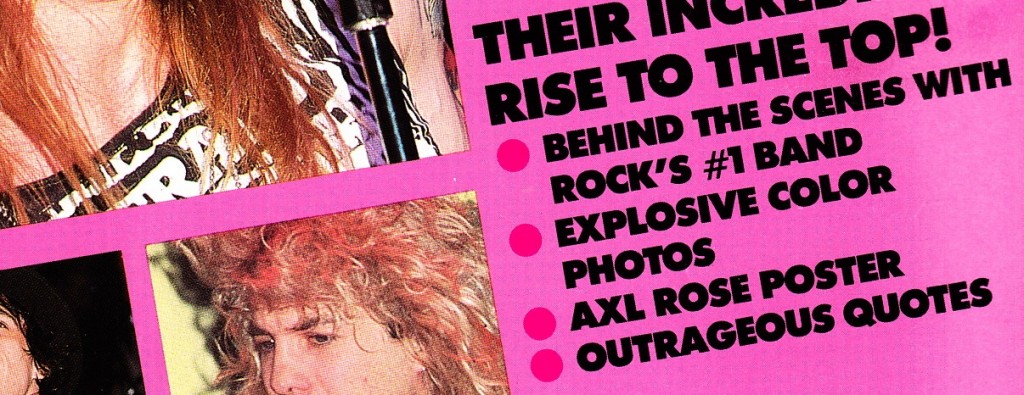 “Home Studios are one of the fastest-growing segments of the music equipment industry. The availability of (fill in the blank) is killing the low-end professional studio scene. After all, why should musicians pay $1,000 to record on someone else’s four-or-eight track system when they can purchase their own system for the same price?”
“Home Studios are one of the fastest-growing segments of the music equipment industry. The availability of (fill in the blank) is killing the low-end professional studio scene. After all, why should musicians pay $1,000 to record on someone else’s four-or-eight track system when they can purchase their own system for the same price?”
Download a 2-pp article from CIRCUS magazine, 1989, on the subject of Home Studio Recorders. Author is one R. J. Grula. (via The More Things Change ETC dept.)
DOWNLOAD: Circus_4trk_1989_0001
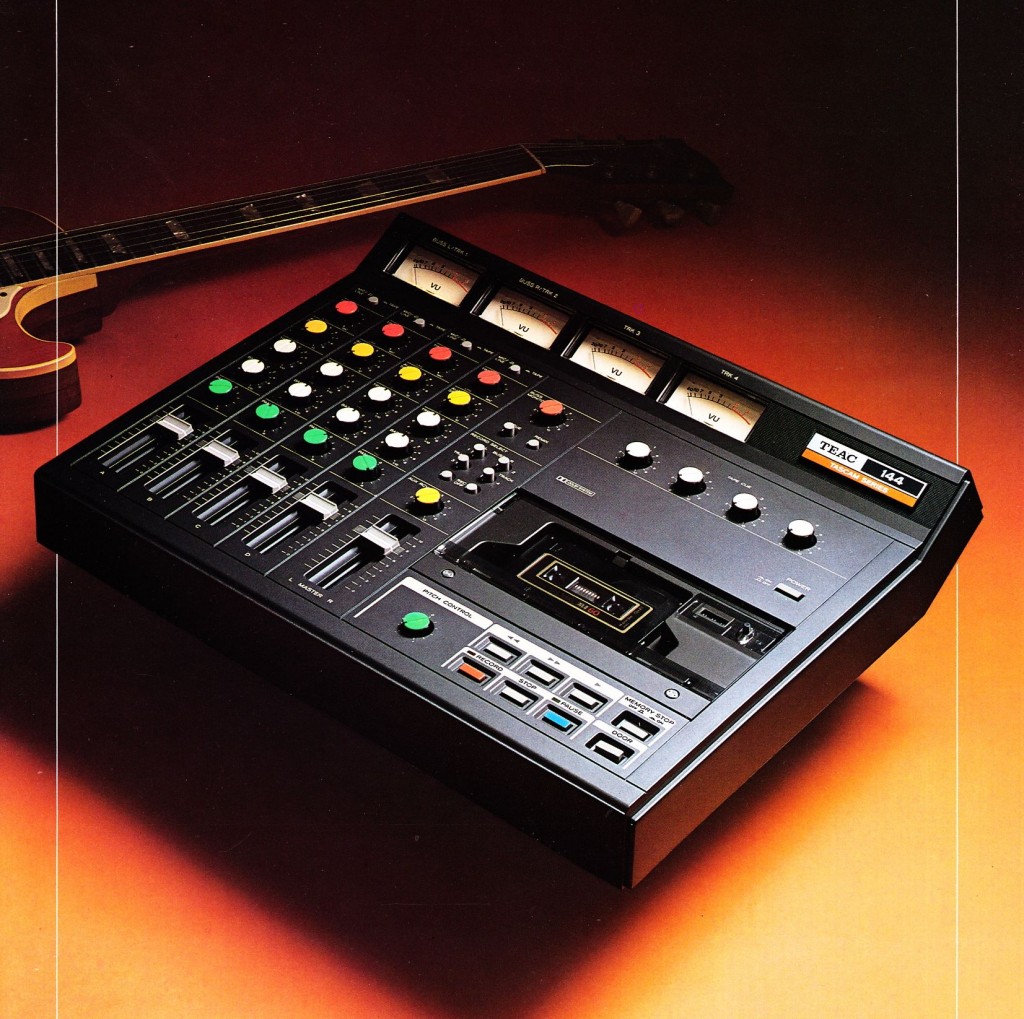 Download the original 6pp brochure/catalog for the Tascam 144, the first ‘4-track’ ‘porta-studio’:
Download the original 6pp brochure/catalog for the Tascam 144, the first ‘4-track’ ‘porta-studio’:
DOWNLOAD: Tascam_144_Catalog
I’m a little embarrassed to admit/realize that this is the third post we’ve done on the 144. First was this article regarding 4-track aesthetics, followed by this post containing the 144 product-launch advertising. I just recently came across this original promo item, and it seems that no one else had bothered to put it online, so what the hell. I’ve already said enough about this crucial, paradigm-shifting object, so I won’t repeat myself here… check the old posts if you care.
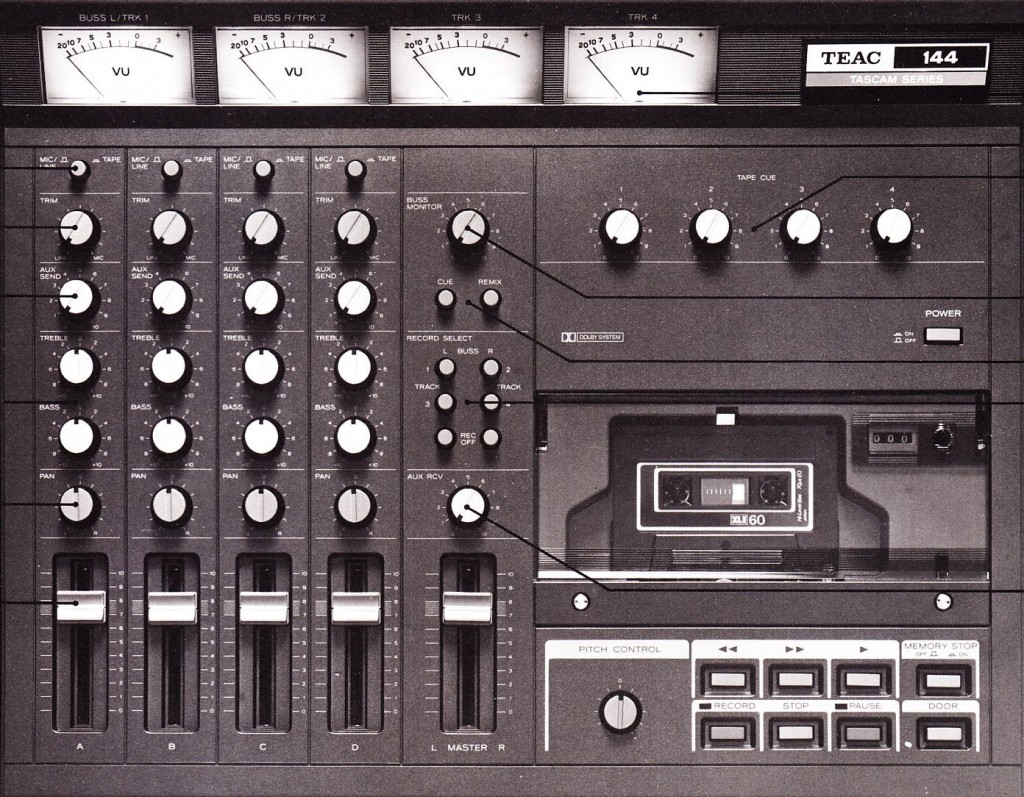
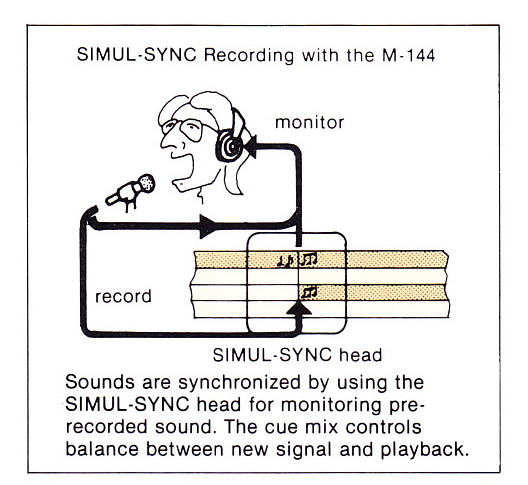 Shit, how did they know what kinda glasses I wear? Oh wait I’m stuck in 1979. Riiiiiiiiiight.
Shit, how did they know what kinda glasses I wear? Oh wait I’m stuck in 1979. Riiiiiiiiiight.
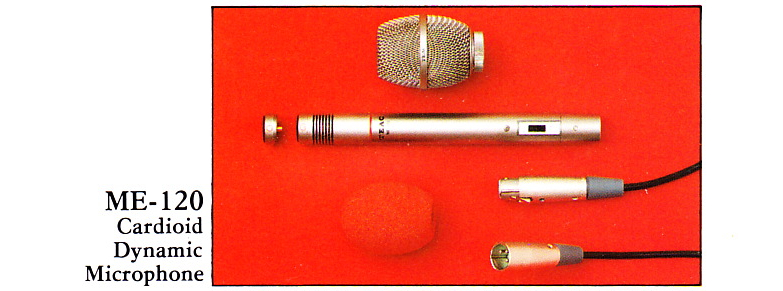 The catalog also contains info on a number of ‘accessories’ that Tascam offered in conjunction with this machine; above, their top-end mic the “ME-120” which came with interchangeable omni and cardiod capsules. Pretty fancy Tascam. I have somehow ended up with just the box and omni capsule for one of these things. WTF?
The catalog also contains info on a number of ‘accessories’ that Tascam offered in conjunction with this machine; above, their top-end mic the “ME-120” which came with interchangeable omni and cardiod capsules. Pretty fancy Tascam. I have somehow ended up with just the box and omni capsule for one of these things. WTF?
The Introduction Of The 4-Track
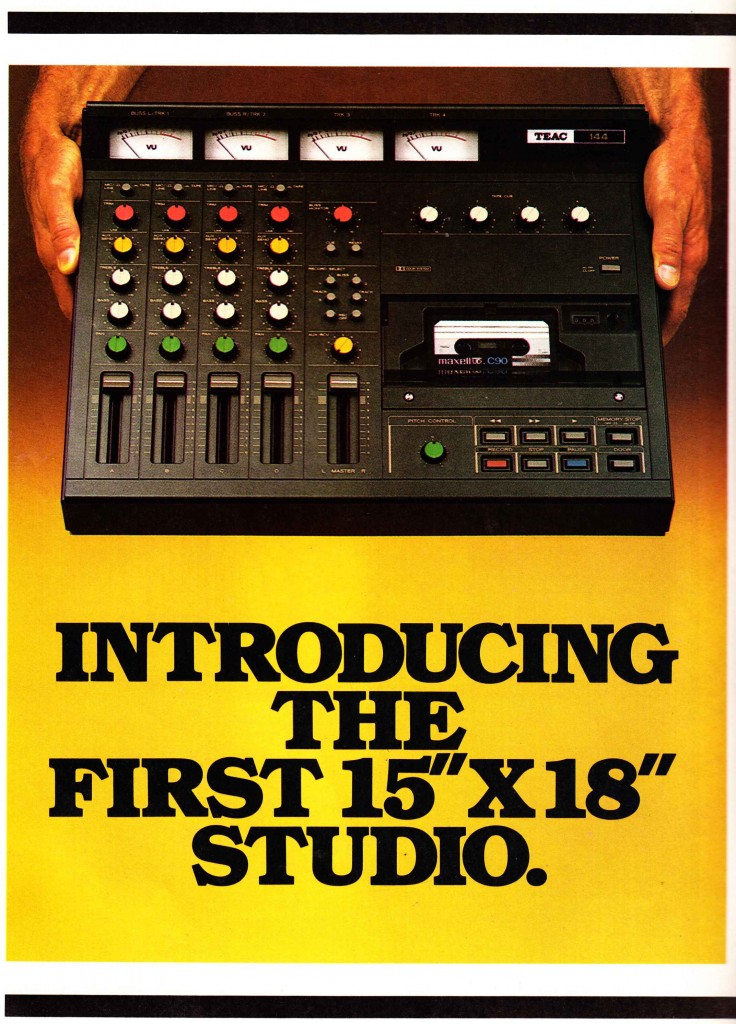
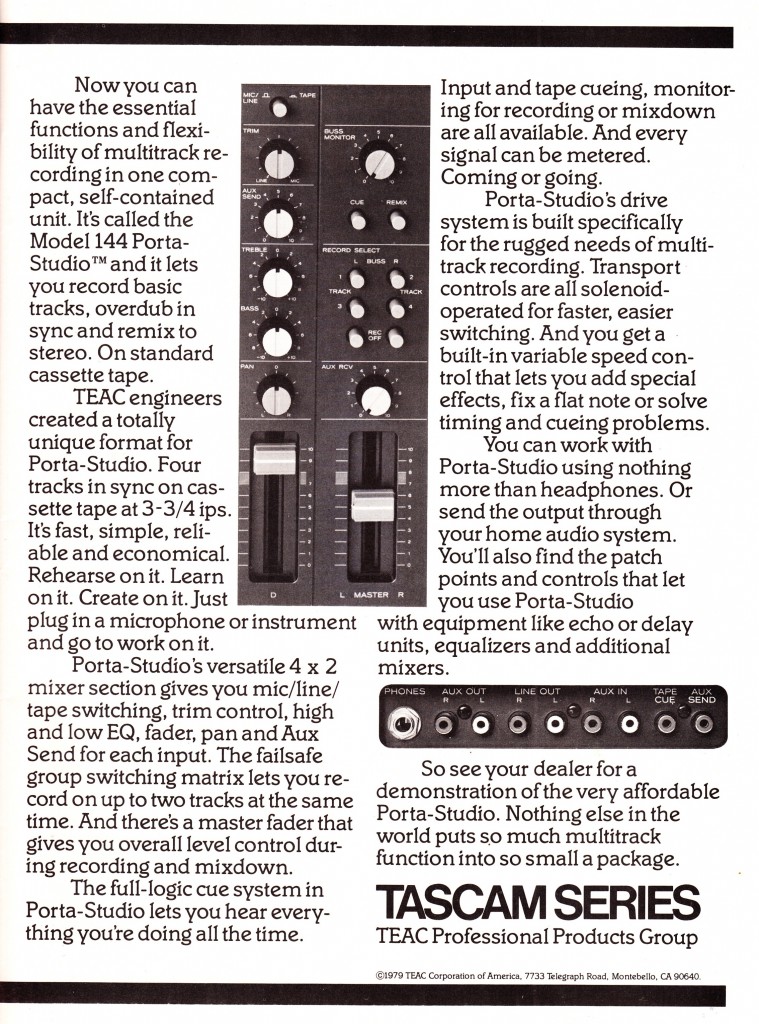 1979. Teac/TASCAM introduces the 144 Porta-Studio, the first four-track integrated tape machine/mixer. The first 4-track. A truly revolutionary product for many reasons, and the first of a product category that would have a profound effect on musical and audio aesthetics of the next 30 years. The two-page spread above is the advert that introduced this product to the public.
1979. Teac/TASCAM introduces the 144 Porta-Studio, the first four-track integrated tape machine/mixer. The first 4-track. A truly revolutionary product for many reasons, and the first of a product category that would have a profound effect on musical and audio aesthetics of the next 30 years. The two-page spread above is the advert that introduced this product to the public.
For all its importance, the 4-track was actually the lesser of two novel cassette-based products introduced by Japanese companies in 1979 which would have a profound global cultural impact. The other one? Click here if you haven’t guessed yet.
For an earlier discussion of the 144 and its legacy, click on this link.
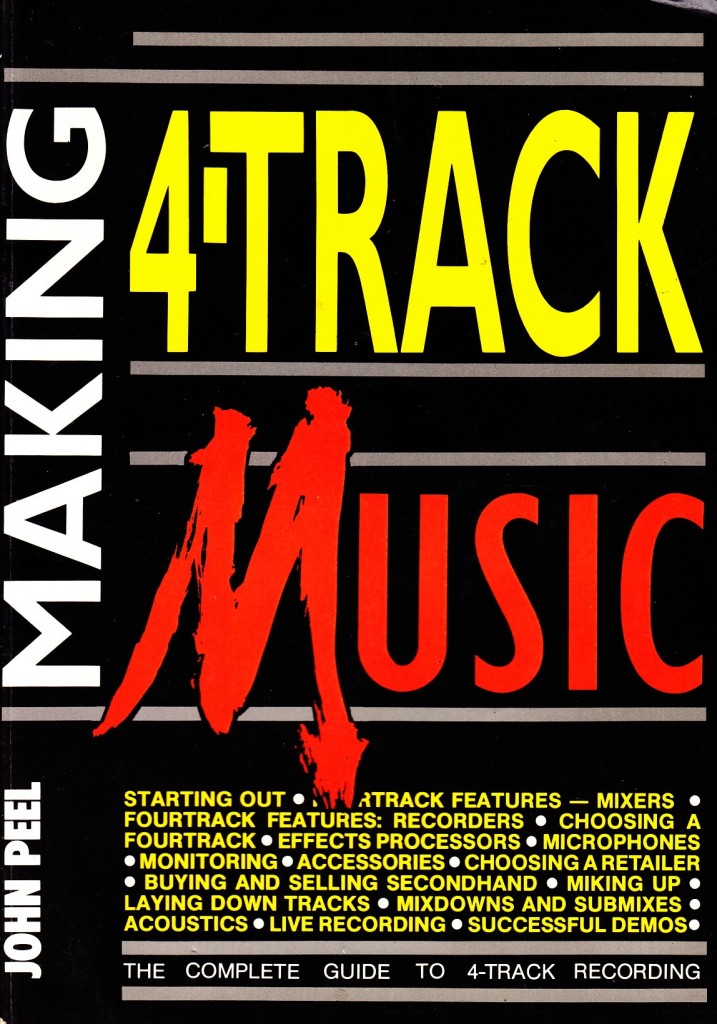 Download a seven-page scan of some interesting hardware on offer in “Making 4-Track Music,” Track Publishing 1987:
Download a seven-page scan of some interesting hardware on offer in “Making 4-Track Music,” Track Publishing 1987:
DOWNLOAD: 4trackMusic_JohnPeel
Includes advertisements for Yamaha MT2X, DX100, and RX17 drum machine; Akai MG614 four-track machine, Tascam Porta2 4-track, Fostex 160, the Boss Micro-Rack series (RDD-20 delay, RPS-10 pitch shifter, RCL-10 compressor, RRV-10 reverb, plus a ton more), and KORG’s multieffects.
*******
***
First-things-first: I have no idea if the ‘John Peel’ to whom this book is credited is the John Peel, he of legendary status as a DJ and taste-maker for an entire generation of rock and pop music. There is nothing whatsoever in this 98pp paperback volume (found in a Manchester OXFAM back in the early 00’s) that offers any indication pro or con. A third option would seem to be the ghostwriter scenario. Anyhow. “Making 4-Track Music” (h.f. “M4TM”) is an A5-sized paperback that attempts to introduce readers to the equipment and processes of using 4-track recorders.
The 4-track recorder, for those unfamiliar, is a category of product first introduced by the TASCAM corporation in 1979 with their model 144.
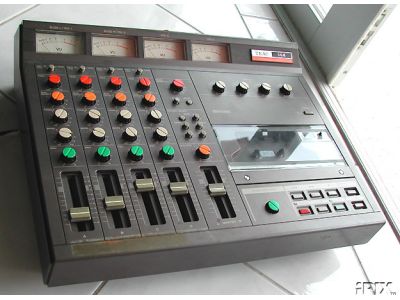 The 1979 TASCAM 144. Bruce Springsteen recorded his greatest album on this small plastic machine, believe-it-or-not. (Image source)
The 1979 TASCAM 144. Bruce Springsteen recorded his greatest album on this small plastic machine, believe-it-or-not. (Image source)
TASCAM already dominated the home-recording market with their 3440 1/4″ open reel tape recorder and the associated mixer-units that were marketed alongside it. These systems had a rather high cost of entry, though: they cost much more than a good used car. The 144 brought the basic concept of multi-track audio recording and mixing to a far lower price-point by using consumer cassette tape rather than 1/4″ open reel tape as the recording media, and by combining the audio-recording device and the audio-mixing apparatus into one single item. This made for a much more affordable system and it also made for easier use: no wires to hook up, no redundant or unnecessary features. Just the basic technology needed to record a performance and then add 3 additional performances in perfect synchronization while retaining the ability to control relative volumes and treatments of each track. With a creative user, the 4-track machine is capable of much more, but this is the basic concept.
“M4TM” covers all of this, and more; there is an explanation of the various recording and mixing features that the consumer would encounter in the marketplace, plus good treatment of the various types of additional processing equipment that a 4-track owner might like: digital time-based effects (delay, etc), compressors, gates, EQs., etc.
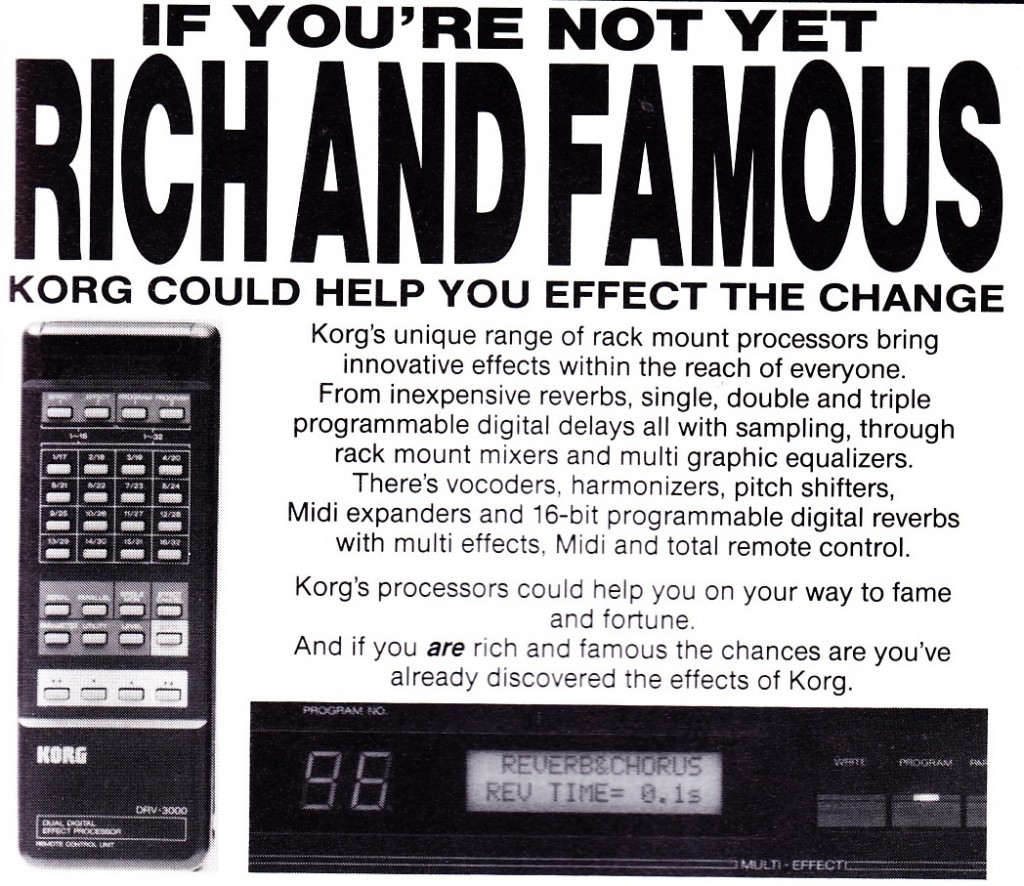 The aesthetics/art of making recordings is not really considered at all; there is a lot of talk about money, costs, (e.g., KORG’s above-depicted rainmaking) and the improved ‘recording quality’ that such expenditures can deliver but no mention of improving the presentation of songs and sonic ideas via any of this technology. Here’s a typical passage:
The aesthetics/art of making recordings is not really considered at all; there is a lot of talk about money, costs, (e.g., KORG’s above-depicted rainmaking) and the improved ‘recording quality’ that such expenditures can deliver but no mention of improving the presentation of songs and sonic ideas via any of this technology. Here’s a typical passage:
As someone who’s work is largely based on the commercial recording studio that I own and operate, I find it rather… alarming/offensive that the prime benefit of making a recording in a pro studio is the sound-quality, to extent that this benefit could be completely undone by several generations of tape-duplication. Jesus. I like to hope that I give my clients something more than a good signal-noise ratio and even frequency response. The passage above kind of makes it seem like it’s the EQUIPMENT in a studio that is doing the work, rather than the engineer… is this how most musicians feel about studios? Is this how I used to feel about studios, when I was 4-tracking at home at age 19?
(me at home, age 19: via Tascam Porta 03, Boss Micro -Rack effects): 07 The End
Furthermore, M4TM does not even entertain the aesthetic or artistic possibilities of all of this ‘4-track’ equipment. Rather, the emphasis is very much on ‘making-a-demo’ en route to possibly getting a ‘record deal,’ and all that this will entail (presumably the “Riches and Fame” for which you will have KORG to thank). The idea of possibly creating a compelling piece of artwork with this equipment is simply absent.
I wonder when this changed. By the time I started recording heavily on a four 4-track machine, a mere 8 years later (1995), musicians like Bill Callahan (aka SMOG) and Jeff Mangum (aka Neutral Milk Hotel) were already getting attention specifically as masters of 4-track recording. These guys did not appear too interested in making a ‘real record’ in a ‘pro studio.’ The 4-track medium, with its attendant tape hiss, awkward usage once you went past four tracks, and total absence of any sort of editing ability, was a huge part of the artwork that they created. Artwork that has truly endured.
I went to see Jeff Mangum perform last week here in CT. He did a solo set at the Shubert Theatre in New Haven. Jeff Mangum has not released a major album of his own in 13 years. The Shubert was nearly sold-out to it’s 1591 capacity.
Have a listen (above) to “Naomi” from Neutral Milk Hotel’s 1996 4-track masterpiece “On Avery Island.” Would these songs have been rendered any more compelling had they been tracked and mixed in a studio? I think we all know the answer to that… Ultimately, though, what Mangum’s solo-acoustic-gtr-and-voice performance at the Shubert last week demonstrated to me was more the fact that it probably honestly didn’t matter how he had made those seminal recordings: the songs themselves are so good and his voice and affect are so well-wrought that their properties can impress regardless of the presentation.
Perhaps I am reading into this all too much…perhaps my ideas and taste are a bit ‘off’ and therefore I have ‘niche’ values. Mangum seems, to me, to be a very straightforward singer/songwriter.. but perhaps my appreciation for artists like Jeff Mangum simply indicates that I have ‘weird’ taste, that I am out-of-step with ‘mainstream’ values… Goggle seems to think so. Here’s what you will see if you play a Neutral Milk Hotel song on Youtube:
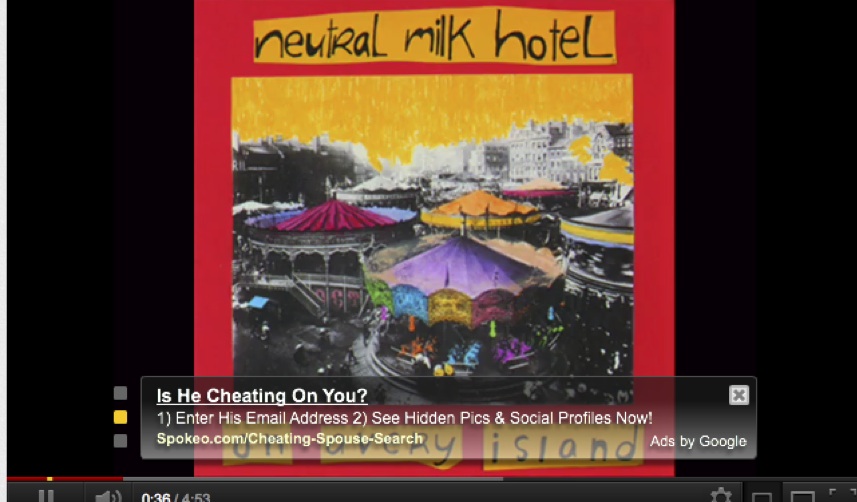
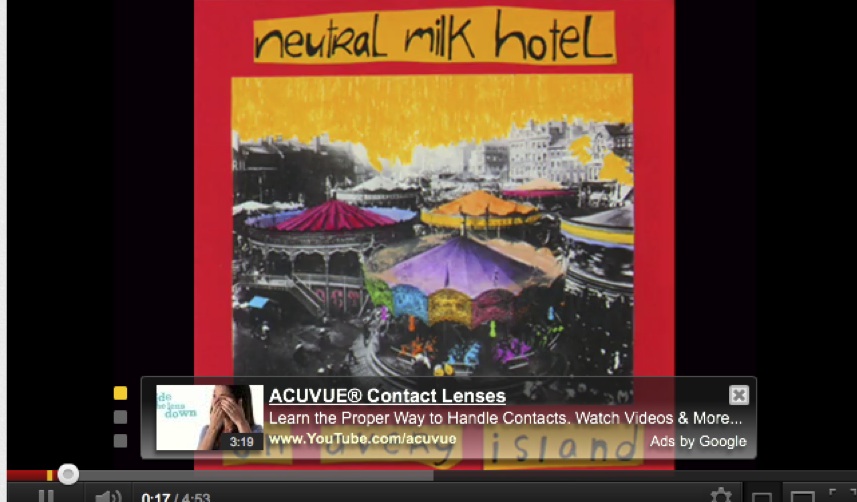
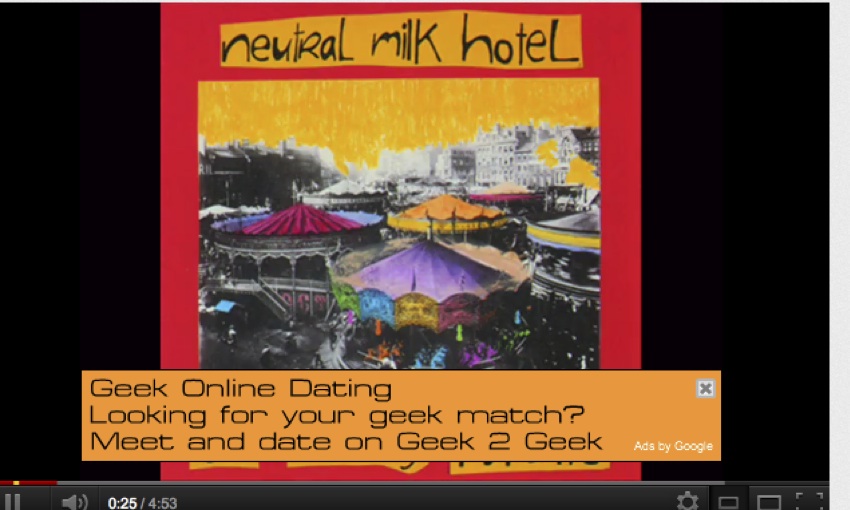

 Is your significant-other cheating on you? Maybe you need to lose those glasses: improve yr appeal? Fuck it, man, you’re a GEEK. Face it. Geek geek geek. Date another geek.
Is your significant-other cheating on you? Maybe you need to lose those glasses: improve yr appeal? Fuck it, man, you’re a GEEK. Face it. Geek geek geek. Date another geek.
I am so confused.
1987/2012: Maybe our John Peel simply wrote “M4TM” in a lost era, simple as that… an era when there still was a vigorous economic basis for the music-recording-industry and therefore the idea of recording music as INDUSTRY rather than EXPLOIT was still the dominant theme. It’s also interesting to consider that around the time of the first Neutral Milk Hotel album we also saw the introduction of Tape Op magazine, the first (that I am aware of…) widely-distributed publication that embraced the ethos of home-recording as a serious art form. And all of this happened just-in-time for the introduction of the first affordable DAWs (e.g., Pro Tools LE), which completely changed both the technique and the aesthetics of audio recording forever. You still need to be able to write a good song though. That much hasn’t changed.
Previous 4-track coverage on PS dot com:
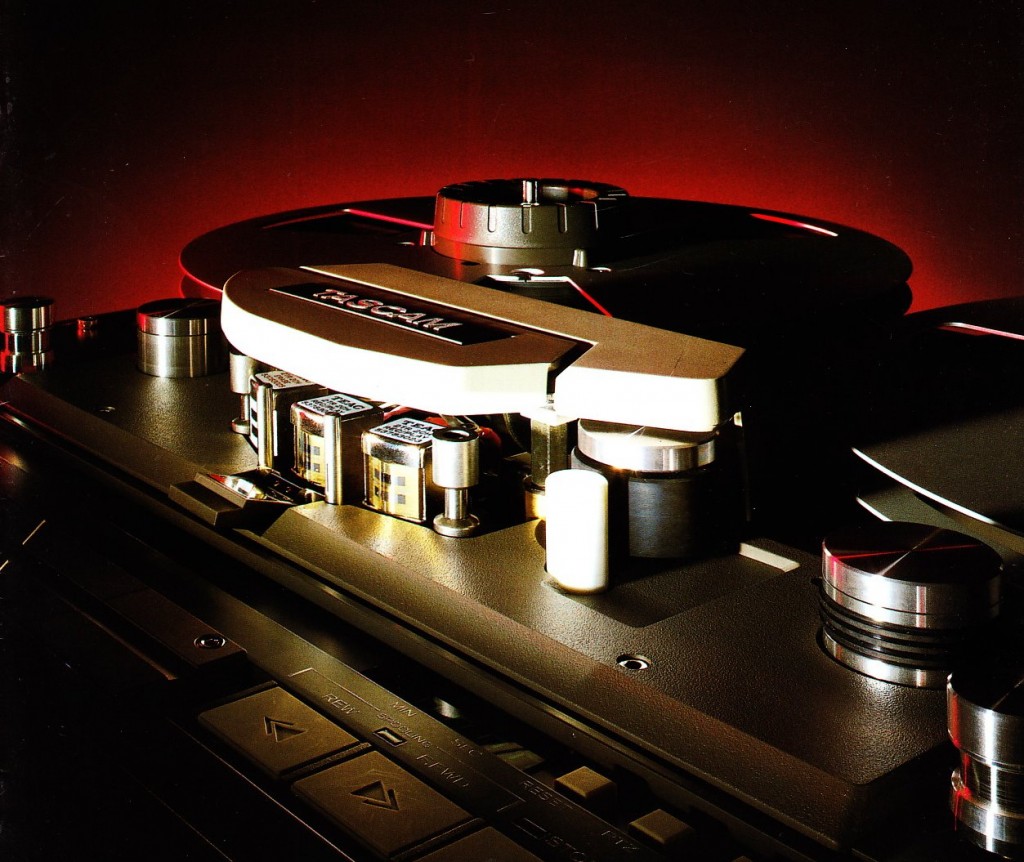 Download the complete twelve-page Tascam Series 40 catalog, c. 1984:
Download the complete twelve-page Tascam Series 40 catalog, c. 1984:
DOWNLOAD: Tascam40series1984
Products covered, with extensive text, specs, and photos, include: Tascam 42 1/4″ stereo tape machine, Tascam 44 four-track 1/4″ tape machine, and Tascam 48 1/2″ eight-track tape machine.
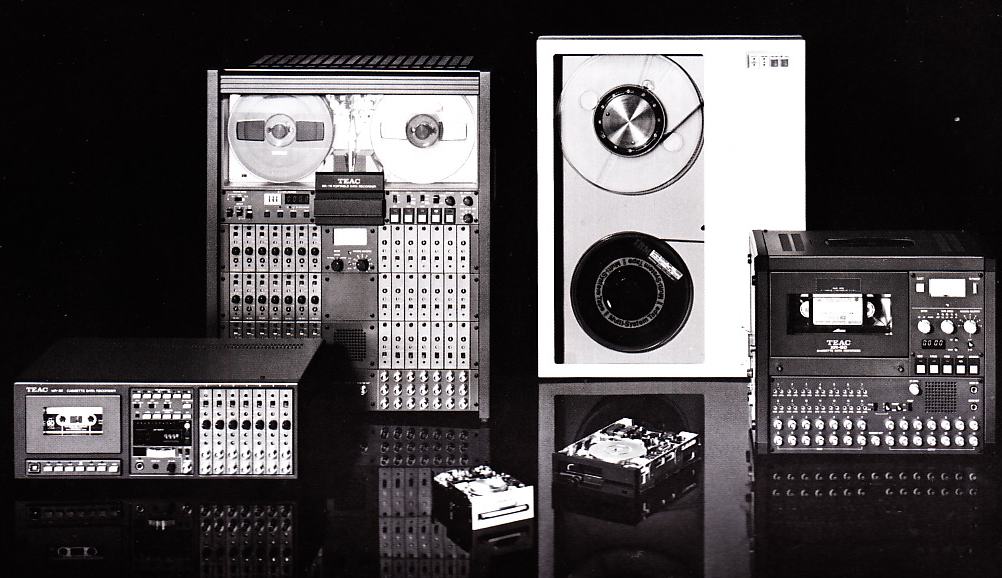 above: Tascam’s various data recorders of the early eighties. 21-track 1/2″ anyone?
above: Tascam’s various data recorders of the early eighties. 21-track 1/2″ anyone?
Tascam helped create the category of ‘home-recording-studio’ in the 1970s with their 4-track reel to reel machines. The 3440, Teac 3340, and Tascam 40-4 and 80-8 tape machines were the backbone of thousands of home studios and project studios. This line-up was improved in the 1980s with the introduction of the Series 40. The Tascam 42, 44, and 48 tape machines offered better performance than the older models, plus standard features such as balanced i/o, varispeed, and confidence monitoring (IE, they are all three-head decks). The battleship-grey finish of the series 40 lets you know that these are commercial/industrial machines, and the 70/80 lb weight reinforces that idea. (N.B. – Tascam also offered a series 50 with even better specs; i have no direct experience with these machines tho…)
The Tascam 48
Many years ago I inherited a couple dozen pro reel-to-reel machines from a media company that had updated to DAT. Otari 50/50s, Tascam 22s and 32s, Technics 1500s, etc… The best unit of the bunch was a Tascam 44. The operational characteristics and sonics of that machine were incredible. It is long gone now, like all the others, sacrificed to pay-the-rent in late 90’s Williamsburg. It’s one of the few studio pieces that I really regret selling. I don’t think I would ever go back to analog tape as a working production format, but as an effect of sorts analog tape has a quality that nothing else can deliver. Just yesterday I was in the studio with E’s Marantz dual-cassette deck, bouncing some submixes onto a Type 1 Sony cassette and then back into Pro Tools, trying to get just the right amount of high and low end breakup. I got it right after about ten attempts with different level settings. A three-head machine would have been very useful in that situation… especially one with varispeed.
Anyone still using a Tascam 44 or 48 for music production? Drop a line and let us know…
Musician Magazine 1976 -1999
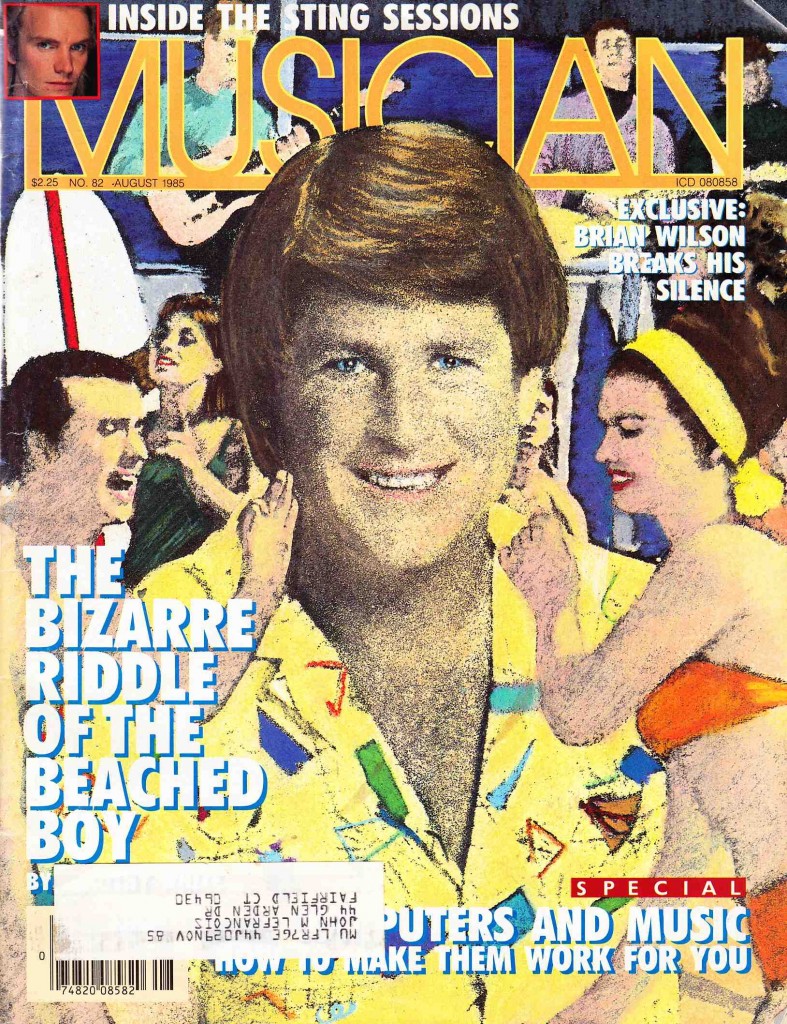 What if I told you that there was a music magazine which featured writers including rock-lit luminaries Lester Bangs and Cameron Crowe; exceptionally strong graphic design; and coverage of the most successful mainstream and most vital ‘underground’ artists of the day; all aimed not at music fans, but at musicians themselves. This publication was called, plainly, MUSICIAN, and it’s worth a look. From Wikipedia:
What if I told you that there was a music magazine which featured writers including rock-lit luminaries Lester Bangs and Cameron Crowe; exceptionally strong graphic design; and coverage of the most successful mainstream and most vital ‘underground’ artists of the day; all aimed not at music fans, but at musicians themselves. This publication was called, plainly, MUSICIAN, and it’s worth a look. From Wikipedia:
“Musician …was a monthly magazine that covered news and information about American popular music. Initially called “Music America”, it was founded in 1976 by Sam Holdsworth and Gordon Baird. (…) Subtitled “The Art, Business and Technology of Making Music,” it became known for its extended and thorough articles about the stars of rock music. “Musician” was not intended to be a fan magazine—the founders envisioned it as a publication about the musician’s craft, and as a result, it earned it the respect of people in the music business. As Holdsworth told an interviewer in 2003, the magazine “…created a level of trust that made the musicians feel they were talking with peers.” In that same article, he noted that “Musician” was also known for finding out the little things that the average magazine did not—such as why a musician chose a particular brand of instrument, or what was the inspiration for a certain song.”
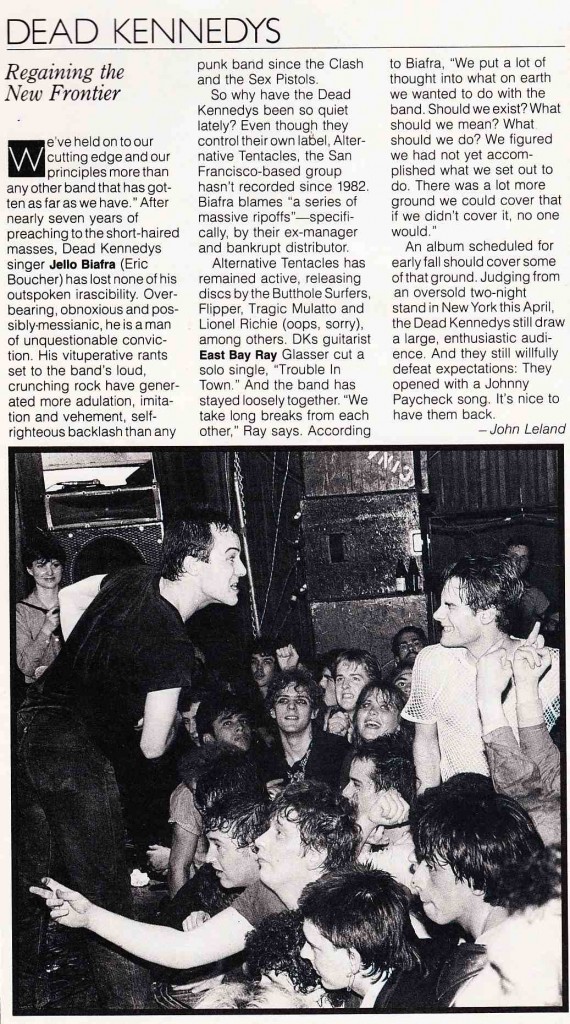 The Dead Kennedys in MUSICIAN, August 1985
The Dead Kennedys in MUSICIAN, August 1985
I have always been struck by how much more candid musicians are when speaking to musician-oriented publications rather than the popular or music-fan press. Old issues of Guitar Player magazine come to mind in this regard. MUSICIAN mag offers much of the same. The intended audience here is musicians, specifically; not recording engineers; but there is still some interesting historical bits for audio fans. If you chance upon a pile of old issues, pick em up. Some revealing advertising from the August 1985 issue:
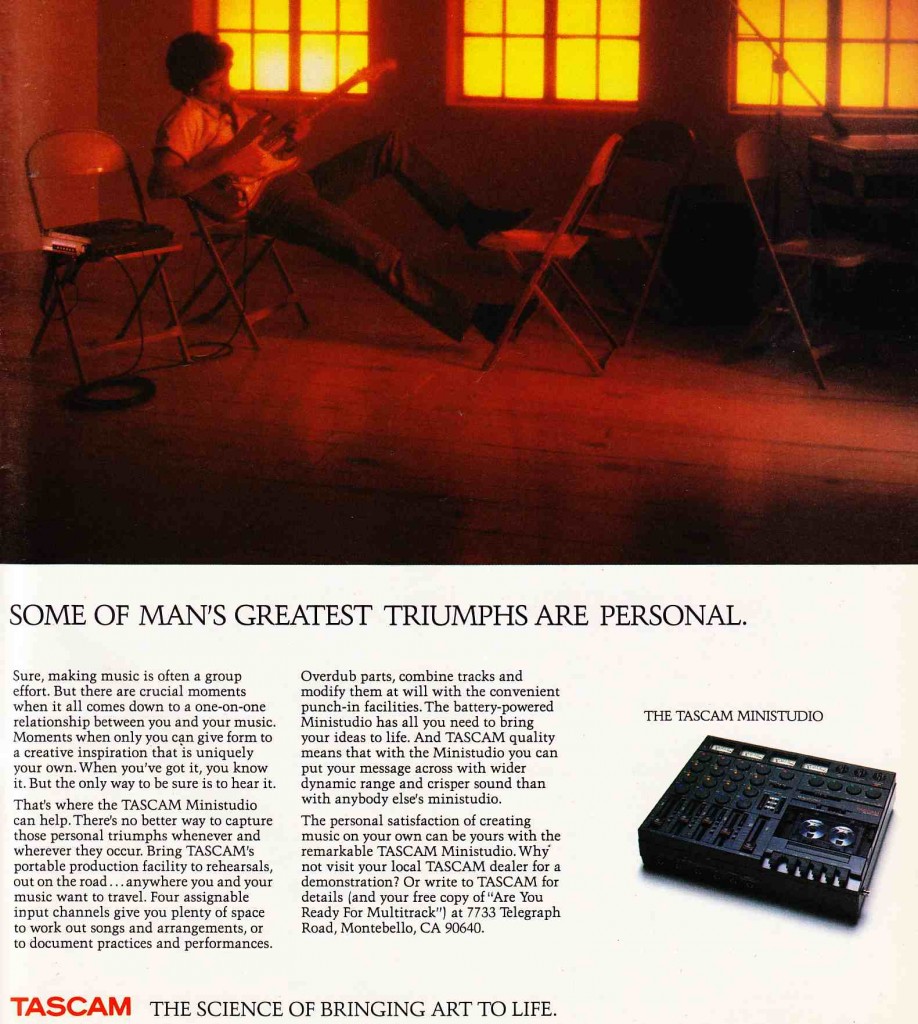 The Tascam Porta 01, which was a lower-priced alternative to their 144/244/246 cassette four-track. Note the light of God/Genius/Art streaming through the windows.
The Tascam Porta 01, which was a lower-priced alternative to their 144/244/246 cassette four-track. Note the light of God/Genius/Art streaming through the windows.
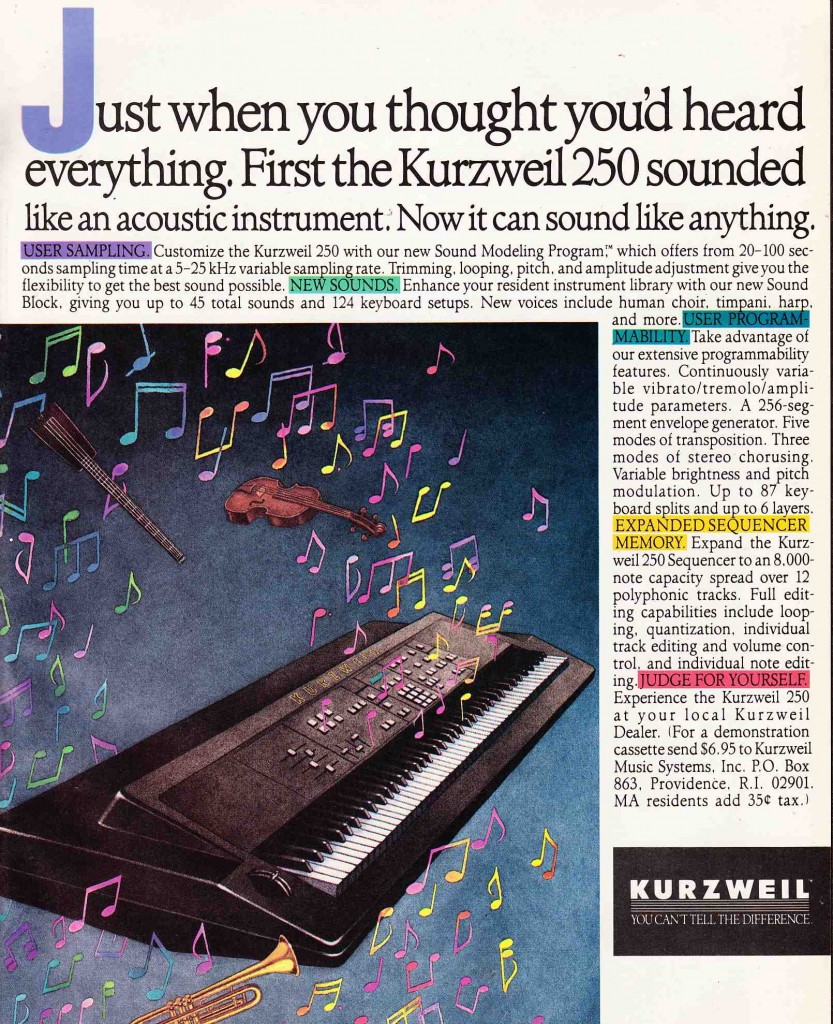 I studied composition at university, and we were taught on the Kurzwel K2500, which was a very high-end synth/sampler in 1995 (approx. $5000 loaded). This is spare change in comparison to the Kurzweil 250 of 1985 (pictured above), which sold for$14,000 – $16,000. That’s THIRTY ONE THOUSAND DOLLARS in today’s money. Good lord.
I studied composition at university, and we were taught on the Kurzwel K2500, which was a very high-end synth/sampler in 1995 (approx. $5000 loaded). This is spare change in comparison to the Kurzweil 250 of 1985 (pictured above), which sold for$14,000 – $16,000. That’s THIRTY ONE THOUSAND DOLLARS in today’s money. Good lord.
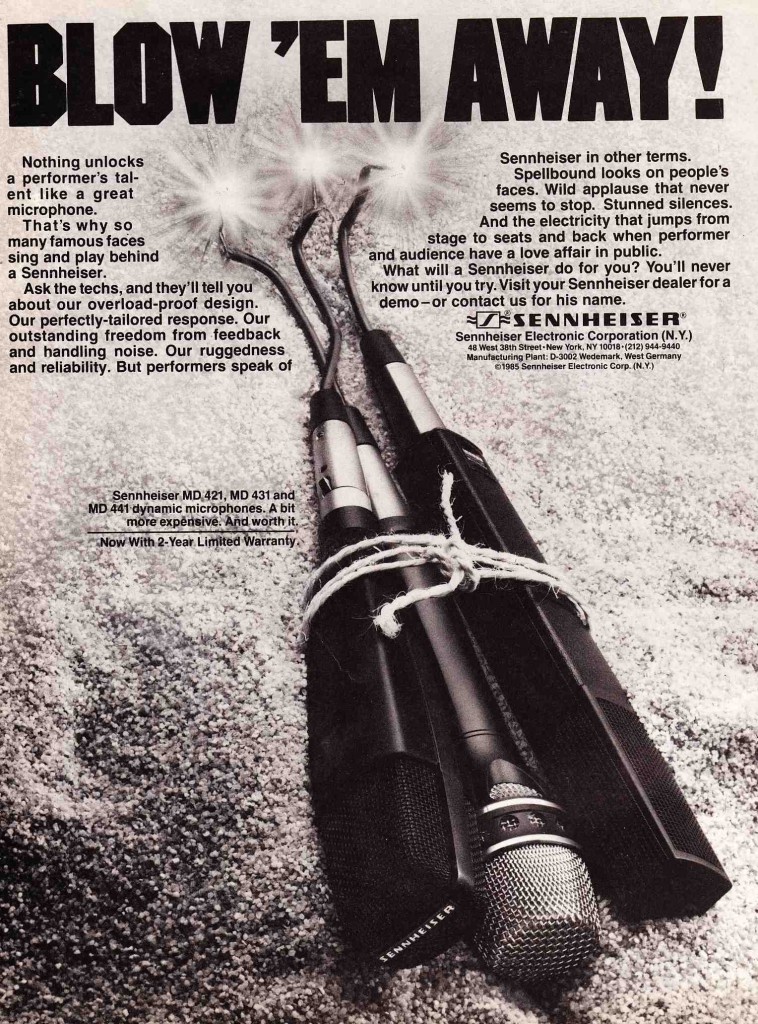 We’ve looked at a lot of 1960s and 1970s Sennhesier 421 ads on this site; here is an 80’s iteration, complete with the ‘blackfire’ 441 of the era.
We’ve looked at a lot of 1960s and 1970s Sennhesier 421 ads on this site; here is an 80’s iteration, complete with the ‘blackfire’ 441 of the era.
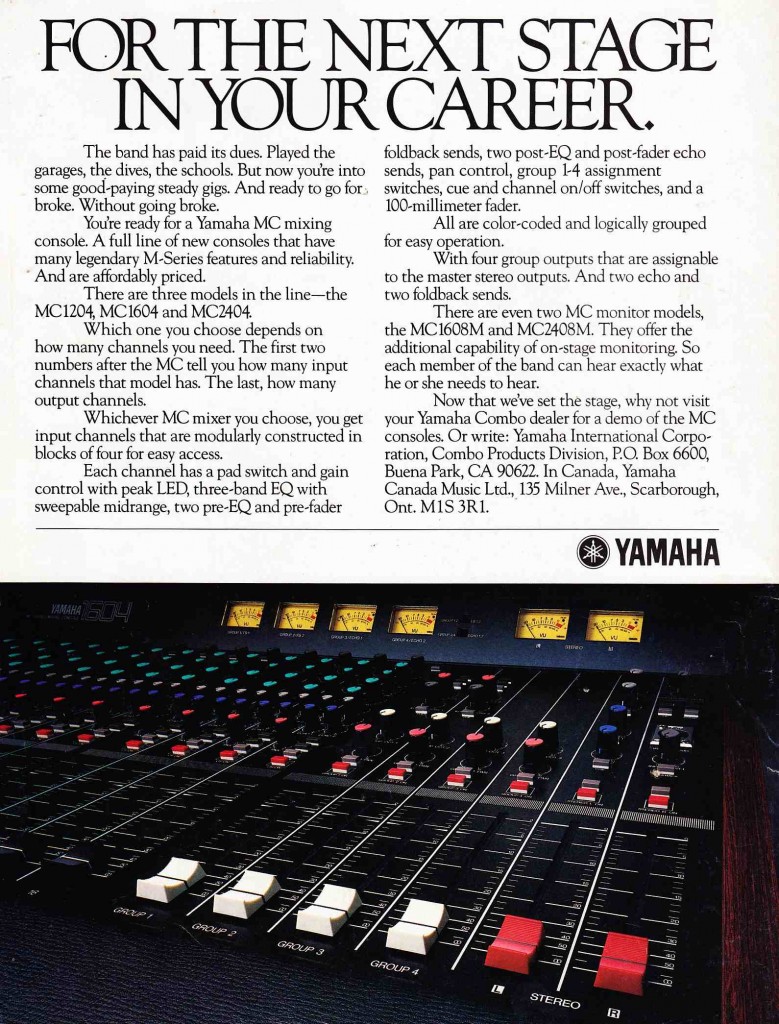 There is a lot of emphasis in the advertising on ‘professional,’ ‘career,’ ‘making it happen,’ etc. Not sure if we can read this as an appearance of the unavoidable-in-the-1980’s ‘yuppie’ zeitgeist but it certainly stands out today as odd language to find in a musician (artist) space, which we generally populate with romantic ‘creative’ and ‘expressive’ concepts.
There is a lot of emphasis in the advertising on ‘professional,’ ‘career,’ ‘making it happen,’ etc. Not sure if we can read this as an appearance of the unavoidable-in-the-1980’s ‘yuppie’ zeitgeist but it certainly stands out today as odd language to find in a musician (artist) space, which we generally populate with romantic ‘creative’ and ‘expressive’ concepts.
